A Review of Hand Hygiene Practices in Emergency Medical Services
VerifiedAdded on 2022/01/04
|19
|5466
|28
Literature Review
AI Summary
This literature review examines hand hygiene practices within Emergency Medical Services (EMS), emphasizing their crucial role in preventing healthcare-associated infections (HAIs). The review highlights the importance of handwashing among EMS personnel, citing studies that reveal poor compliance and its impact on patient safety. It discusses the significance of hand hygiene training, effective handwashing techniques, and the five moments for hand hygiene as recommended by WHO. The review also explores challenges such as time constraints and workload, and promotes the use of alcohol-based hand sanitizers. The review emphasizes the cost-effectiveness of hand hygiene in preventing the spread of infections and the need for strict policies and multifaceted interventions to improve compliance in both hospital and clinic settings. The review also looks at the importance of handwashing in emergency situations and the use of effective techniques to prevent the spread of diseases.
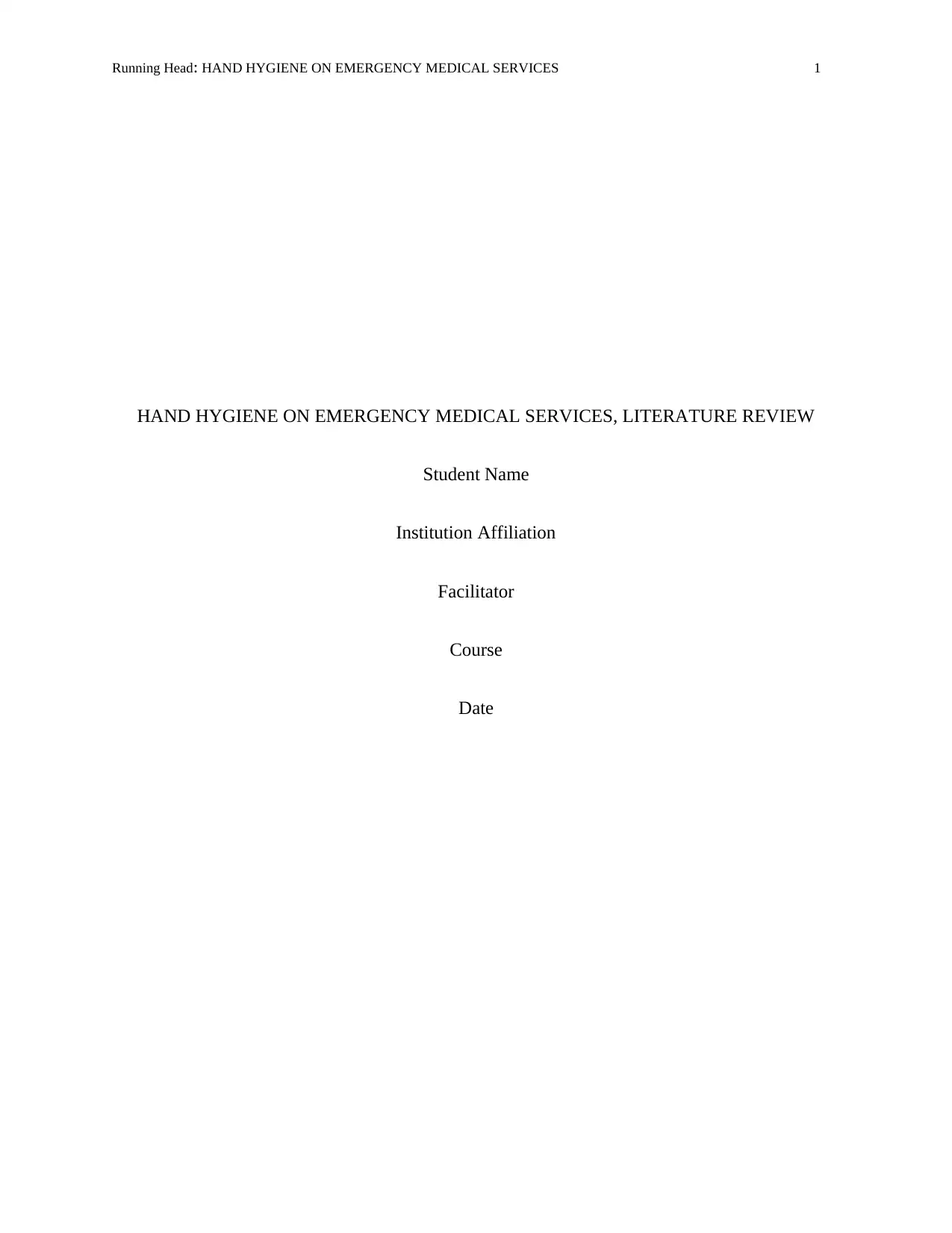
Running Head: HAND HYGIENE ON EMERGENCY MEDICAL SERVICES 1
HAND HYGIENE ON EMERGENCY MEDICAL SERVICES, LITERATURE REVIEW
Student Name
Institution Affiliation
Facilitator
Course
Date
HAND HYGIENE ON EMERGENCY MEDICAL SERVICES, LITERATURE REVIEW
Student Name
Institution Affiliation
Facilitator
Course
Date
Paraphrase This Document
Need a fresh take? Get an instant paraphrase of this document with our AI Paraphraser
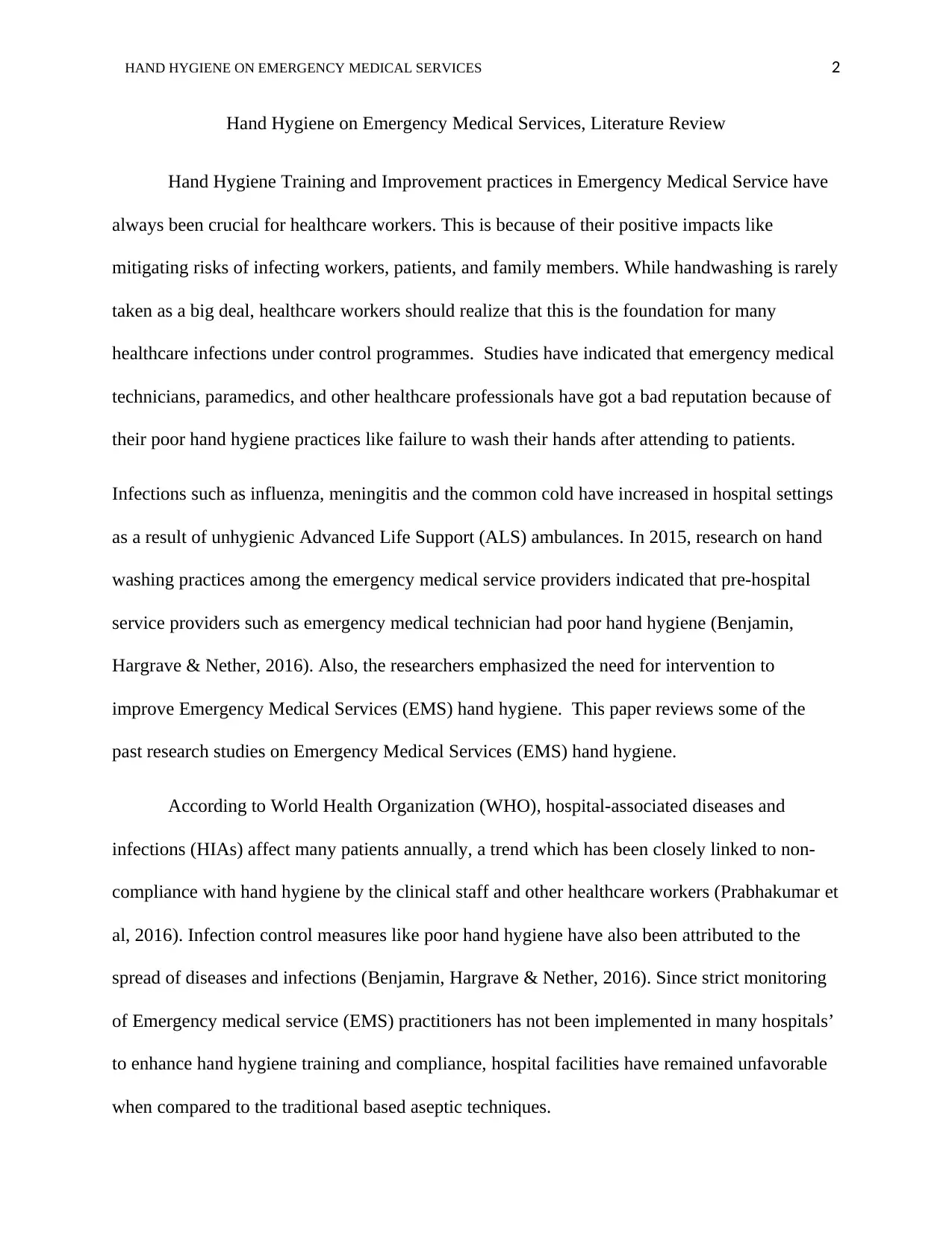
HAND HYGIENE ON EMERGENCY MEDICAL SERVICES 2
Hand Hygiene on Emergency Medical Services, Literature Review
Hand Hygiene Training and Improvement practices in Emergency Medical Service have
always been crucial for healthcare workers. This is because of their positive impacts like
mitigating risks of infecting workers, patients, and family members. While handwashing is rarely
taken as a big deal, healthcare workers should realize that this is the foundation for many
healthcare infections under control programmes. Studies have indicated that emergency medical
technicians, paramedics, and other healthcare professionals have got a bad reputation because of
their poor hand hygiene practices like failure to wash their hands after attending to patients.
Infections such as influenza, meningitis and the common cold have increased in hospital settings
as a result of unhygienic Advanced Life Support (ALS) ambulances. In 2015, research on hand
washing practices among the emergency medical service providers indicated that pre-hospital
service providers such as emergency medical technician had poor hand hygiene (Benjamin,
Hargrave & Nether, 2016). Also, the researchers emphasized the need for intervention to
improve Emergency Medical Services (EMS) hand hygiene. This paper reviews some of the
past research studies on Emergency Medical Services (EMS) hand hygiene.
According to World Health Organization (WHO), hospital-associated diseases and
infections (HIAs) affect many patients annually, a trend which has been closely linked to non-
compliance with hand hygiene by the clinical staff and other healthcare workers (Prabhakumar et
al, 2016). Infection control measures like poor hand hygiene have also been attributed to the
spread of diseases and infections (Benjamin, Hargrave & Nether, 2016). Since strict monitoring
of Emergency medical service (EMS) practitioners has not been implemented in many hospitals’
to enhance hand hygiene training and compliance, hospital facilities have remained unfavorable
when compared to the traditional based aseptic techniques.
Hand Hygiene on Emergency Medical Services, Literature Review
Hand Hygiene Training and Improvement practices in Emergency Medical Service have
always been crucial for healthcare workers. This is because of their positive impacts like
mitigating risks of infecting workers, patients, and family members. While handwashing is rarely
taken as a big deal, healthcare workers should realize that this is the foundation for many
healthcare infections under control programmes. Studies have indicated that emergency medical
technicians, paramedics, and other healthcare professionals have got a bad reputation because of
their poor hand hygiene practices like failure to wash their hands after attending to patients.
Infections such as influenza, meningitis and the common cold have increased in hospital settings
as a result of unhygienic Advanced Life Support (ALS) ambulances. In 2015, research on hand
washing practices among the emergency medical service providers indicated that pre-hospital
service providers such as emergency medical technician had poor hand hygiene (Benjamin,
Hargrave & Nether, 2016). Also, the researchers emphasized the need for intervention to
improve Emergency Medical Services (EMS) hand hygiene. This paper reviews some of the
past research studies on Emergency Medical Services (EMS) hand hygiene.
According to World Health Organization (WHO), hospital-associated diseases and
infections (HIAs) affect many patients annually, a trend which has been closely linked to non-
compliance with hand hygiene by the clinical staff and other healthcare workers (Prabhakumar et
al, 2016). Infection control measures like poor hand hygiene have also been attributed to the
spread of diseases and infections (Benjamin, Hargrave & Nether, 2016). Since strict monitoring
of Emergency medical service (EMS) practitioners has not been implemented in many hospitals’
to enhance hand hygiene training and compliance, hospital facilities have remained unfavorable
when compared to the traditional based aseptic techniques.
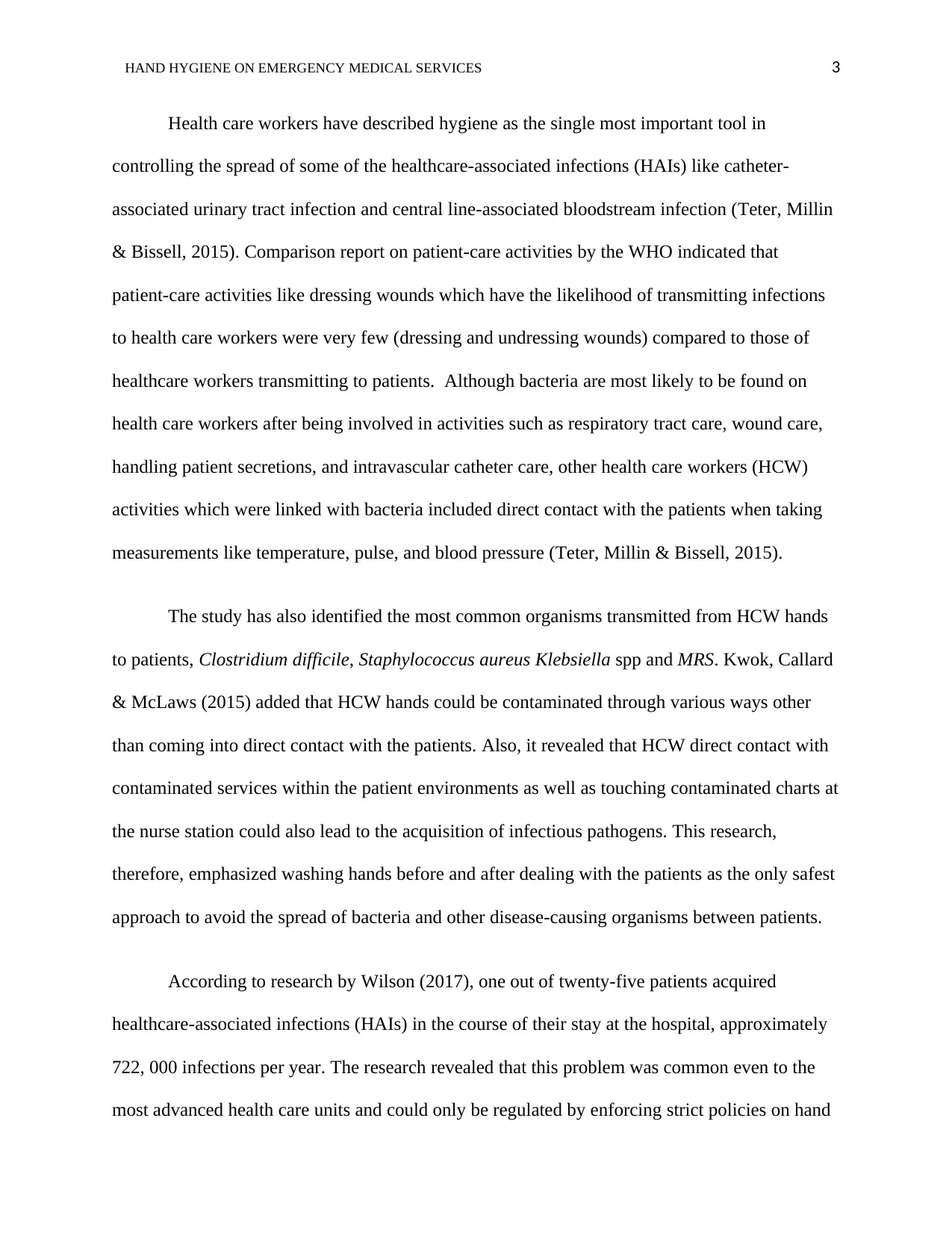
HAND HYGIENE ON EMERGENCY MEDICAL SERVICES 3
Health care workers have described hygiene as the single most important tool in
controlling the spread of some of the healthcare-associated infections (HAIs) like catheter-
associated urinary tract infection and central line-associated bloodstream infection (Teter, Millin
& Bissell, 2015). Comparison report on patient-care activities by the WHO indicated that
patient-care activities like dressing wounds which have the likelihood of transmitting infections
to health care workers were very few (dressing and undressing wounds) compared to those of
healthcare workers transmitting to patients. Although bacteria are most likely to be found on
health care workers after being involved in activities such as respiratory tract care, wound care,
handling patient secretions, and intravascular catheter care, other health care workers (HCW)
activities which were linked with bacteria included direct contact with the patients when taking
measurements like temperature, pulse, and blood pressure (Teter, Millin & Bissell, 2015).
The study has also identified the most common organisms transmitted from HCW hands
to patients, Clostridium difficile, Staphylococcus aureus Klebsiella spp and MRS. Kwok, Callard
& McLaws (2015) added that HCW hands could be contaminated through various ways other
than coming into direct contact with the patients. Also, it revealed that HCW direct contact with
contaminated services within the patient environments as well as touching contaminated charts at
the nurse station could also lead to the acquisition of infectious pathogens. This research,
therefore, emphasized washing hands before and after dealing with the patients as the only safest
approach to avoid the spread of bacteria and other disease-causing organisms between patients.
According to research by Wilson (2017), one out of twenty-five patients acquired
healthcare-associated infections (HAIs) in the course of their stay at the hospital, approximately
722, 000 infections per year. The research revealed that this problem was common even to the
most advanced health care units and could only be regulated by enforcing strict policies on hand
Health care workers have described hygiene as the single most important tool in
controlling the spread of some of the healthcare-associated infections (HAIs) like catheter-
associated urinary tract infection and central line-associated bloodstream infection (Teter, Millin
& Bissell, 2015). Comparison report on patient-care activities by the WHO indicated that
patient-care activities like dressing wounds which have the likelihood of transmitting infections
to health care workers were very few (dressing and undressing wounds) compared to those of
healthcare workers transmitting to patients. Although bacteria are most likely to be found on
health care workers after being involved in activities such as respiratory tract care, wound care,
handling patient secretions, and intravascular catheter care, other health care workers (HCW)
activities which were linked with bacteria included direct contact with the patients when taking
measurements like temperature, pulse, and blood pressure (Teter, Millin & Bissell, 2015).
The study has also identified the most common organisms transmitted from HCW hands
to patients, Clostridium difficile, Staphylococcus aureus Klebsiella spp and MRS. Kwok, Callard
& McLaws (2015) added that HCW hands could be contaminated through various ways other
than coming into direct contact with the patients. Also, it revealed that HCW direct contact with
contaminated services within the patient environments as well as touching contaminated charts at
the nurse station could also lead to the acquisition of infectious pathogens. This research,
therefore, emphasized washing hands before and after dealing with the patients as the only safest
approach to avoid the spread of bacteria and other disease-causing organisms between patients.
According to research by Wilson (2017), one out of twenty-five patients acquired
healthcare-associated infections (HAIs) in the course of their stay at the hospital, approximately
722, 000 infections per year. The research revealed that this problem was common even to the
most advanced health care units and could only be regulated by enforcing strict policies on hand
⊘ This is a preview!⊘
Do you want full access?
Subscribe today to unlock all pages.

Trusted by 1+ million students worldwide
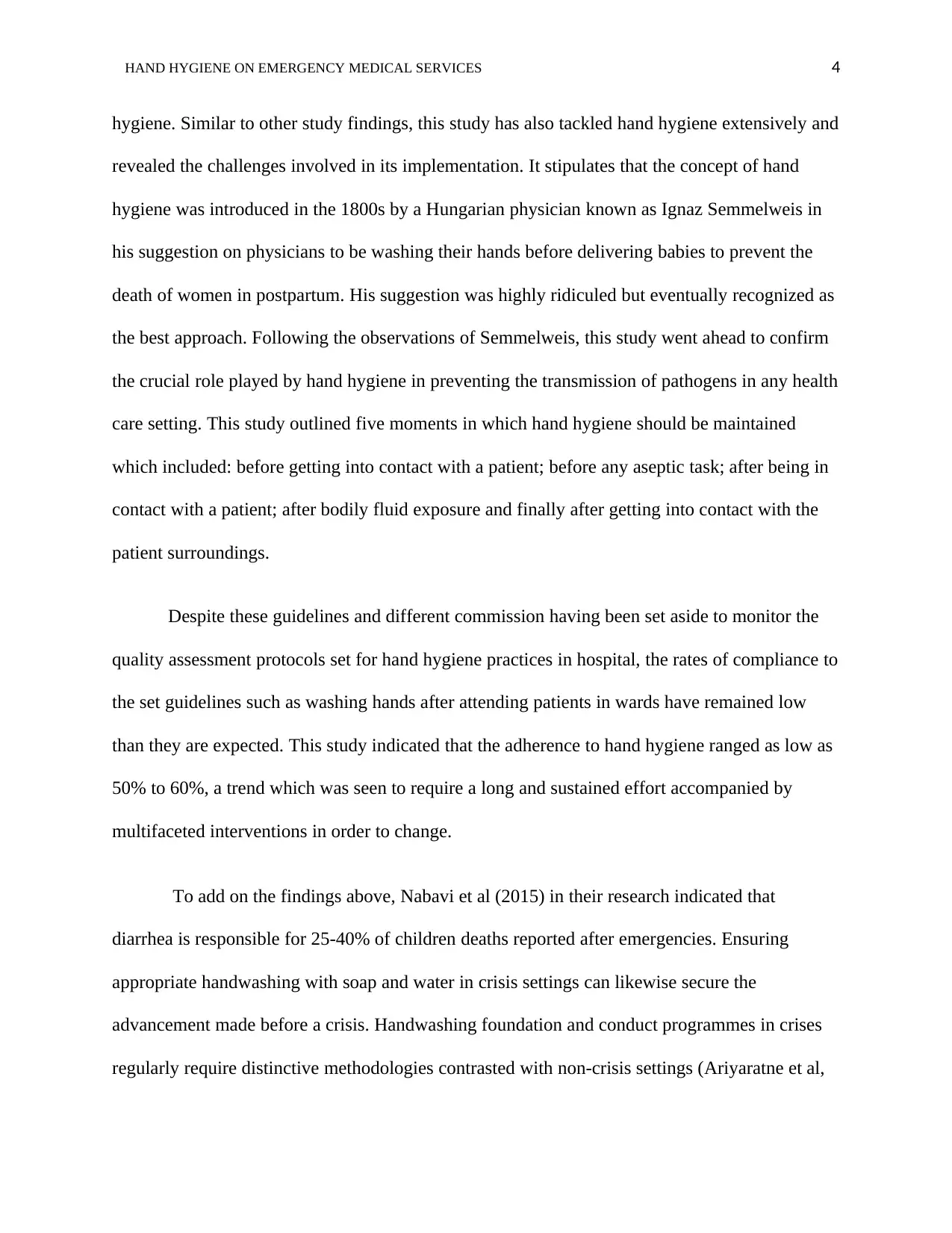
HAND HYGIENE ON EMERGENCY MEDICAL SERVICES 4
hygiene. Similar to other study findings, this study has also tackled hand hygiene extensively and
revealed the challenges involved in its implementation. It stipulates that the concept of hand
hygiene was introduced in the 1800s by a Hungarian physician known as Ignaz Semmelweis in
his suggestion on physicians to be washing their hands before delivering babies to prevent the
death of women in postpartum. His suggestion was highly ridiculed but eventually recognized as
the best approach. Following the observations of Semmelweis, this study went ahead to confirm
the crucial role played by hand hygiene in preventing the transmission of pathogens in any health
care setting. This study outlined five moments in which hand hygiene should be maintained
which included: before getting into contact with a patient; before any aseptic task; after being in
contact with a patient; after bodily fluid exposure and finally after getting into contact with the
patient surroundings.
Despite these guidelines and different commission having been set aside to monitor the
quality assessment protocols set for hand hygiene practices in hospital, the rates of compliance to
the set guidelines such as washing hands after attending patients in wards have remained low
than they are expected. This study indicated that the adherence to hand hygiene ranged as low as
50% to 60%, a trend which was seen to require a long and sustained effort accompanied by
multifaceted interventions in order to change.
To add on the findings above, Nabavi et al (2015) in their research indicated that
diarrhea is responsible for 25-40% of children deaths reported after emergencies. Ensuring
appropriate handwashing with soap and water in crisis settings can likewise secure the
advancement made before a crisis. Handwashing foundation and conduct programmes in crises
regularly require distinctive methodologies contrasted with non-crisis settings (Ariyaratne et al,
hygiene. Similar to other study findings, this study has also tackled hand hygiene extensively and
revealed the challenges involved in its implementation. It stipulates that the concept of hand
hygiene was introduced in the 1800s by a Hungarian physician known as Ignaz Semmelweis in
his suggestion on physicians to be washing their hands before delivering babies to prevent the
death of women in postpartum. His suggestion was highly ridiculed but eventually recognized as
the best approach. Following the observations of Semmelweis, this study went ahead to confirm
the crucial role played by hand hygiene in preventing the transmission of pathogens in any health
care setting. This study outlined five moments in which hand hygiene should be maintained
which included: before getting into contact with a patient; before any aseptic task; after being in
contact with a patient; after bodily fluid exposure and finally after getting into contact with the
patient surroundings.
Despite these guidelines and different commission having been set aside to monitor the
quality assessment protocols set for hand hygiene practices in hospital, the rates of compliance to
the set guidelines such as washing hands after attending patients in wards have remained low
than they are expected. This study indicated that the adherence to hand hygiene ranged as low as
50% to 60%, a trend which was seen to require a long and sustained effort accompanied by
multifaceted interventions in order to change.
To add on the findings above, Nabavi et al (2015) in their research indicated that
diarrhea is responsible for 25-40% of children deaths reported after emergencies. Ensuring
appropriate handwashing with soap and water in crisis settings can likewise secure the
advancement made before a crisis. Handwashing foundation and conduct programmes in crises
regularly require distinctive methodologies contrasted with non-crisis settings (Ariyaratne et al,
Paraphrase This Document
Need a fresh take? Get an instant paraphrase of this document with our AI Paraphraser
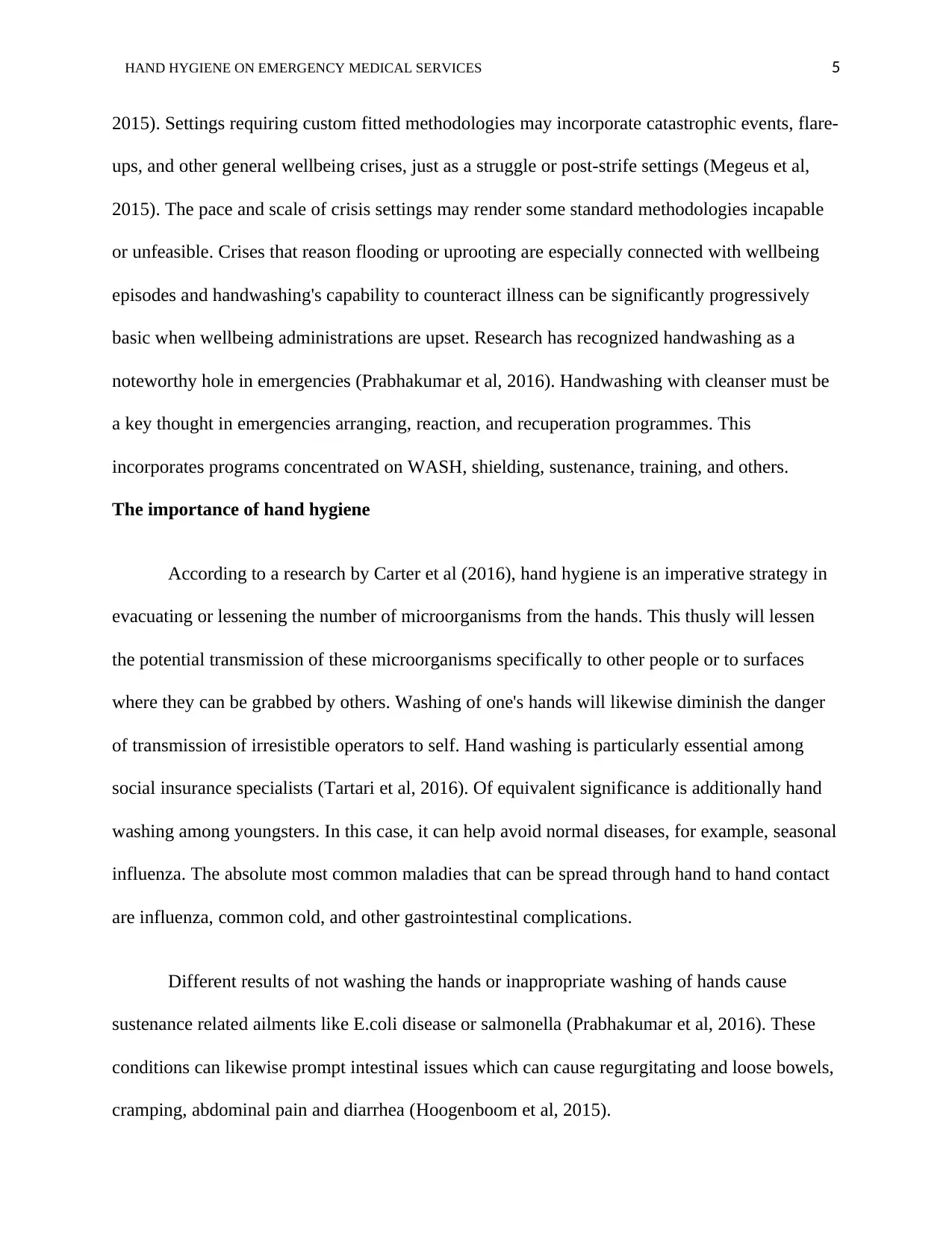
HAND HYGIENE ON EMERGENCY MEDICAL SERVICES 5
2015). Settings requiring custom fitted methodologies may incorporate catastrophic events, flare-
ups, and other general wellbeing crises, just as a struggle or post-strife settings (Megeus et al,
2015). The pace and scale of crisis settings may render some standard methodologies incapable
or unfeasible. Crises that reason flooding or uprooting are especially connected with wellbeing
episodes and handwashing's capability to counteract illness can be significantly progressively
basic when wellbeing administrations are upset. Research has recognized handwashing as a
noteworthy hole in emergencies (Prabhakumar et al, 2016). Handwashing with cleanser must be
a key thought in emergencies arranging, reaction, and recuperation programmes. This
incorporates programs concentrated on WASH, shielding, sustenance, training, and others.
The importance of hand hygiene
According to a research by Carter et al (2016), hand hygiene is an imperative strategy in
evacuating or lessening the number of microorganisms from the hands. This thusly will lessen
the potential transmission of these microorganisms specifically to other people or to surfaces
where they can be grabbed by others. Washing of one's hands will likewise diminish the danger
of transmission of irresistible operators to self. Hand washing is particularly essential among
social insurance specialists (Tartari et al, 2016). Of equivalent significance is additionally hand
washing among youngsters. In this case, it can help avoid normal diseases, for example, seasonal
influenza. The absolute most common maladies that can be spread through hand to hand contact
are influenza, common cold, and other gastrointestinal complications.
Different results of not washing the hands or inappropriate washing of hands cause
sustenance related ailments like E.coli disease or salmonella (Prabhakumar et al, 2016). These
conditions can likewise prompt intestinal issues which can cause regurgitating and loose bowels,
cramping, abdominal pain and diarrhea (Hoogenboom et al, 2015).
2015). Settings requiring custom fitted methodologies may incorporate catastrophic events, flare-
ups, and other general wellbeing crises, just as a struggle or post-strife settings (Megeus et al,
2015). The pace and scale of crisis settings may render some standard methodologies incapable
or unfeasible. Crises that reason flooding or uprooting are especially connected with wellbeing
episodes and handwashing's capability to counteract illness can be significantly progressively
basic when wellbeing administrations are upset. Research has recognized handwashing as a
noteworthy hole in emergencies (Prabhakumar et al, 2016). Handwashing with cleanser must be
a key thought in emergencies arranging, reaction, and recuperation programmes. This
incorporates programs concentrated on WASH, shielding, sustenance, training, and others.
The importance of hand hygiene
According to a research by Carter et al (2016), hand hygiene is an imperative strategy in
evacuating or lessening the number of microorganisms from the hands. This thusly will lessen
the potential transmission of these microorganisms specifically to other people or to surfaces
where they can be grabbed by others. Washing of one's hands will likewise diminish the danger
of transmission of irresistible operators to self. Hand washing is particularly essential among
social insurance specialists (Tartari et al, 2016). Of equivalent significance is additionally hand
washing among youngsters. In this case, it can help avoid normal diseases, for example, seasonal
influenza. The absolute most common maladies that can be spread through hand to hand contact
are influenza, common cold, and other gastrointestinal complications.
Different results of not washing the hands or inappropriate washing of hands cause
sustenance related ailments like E.coli disease or salmonella (Prabhakumar et al, 2016). These
conditions can likewise prompt intestinal issues which can cause regurgitating and loose bowels,
cramping, abdominal pain and diarrhea (Hoogenboom et al, 2015).
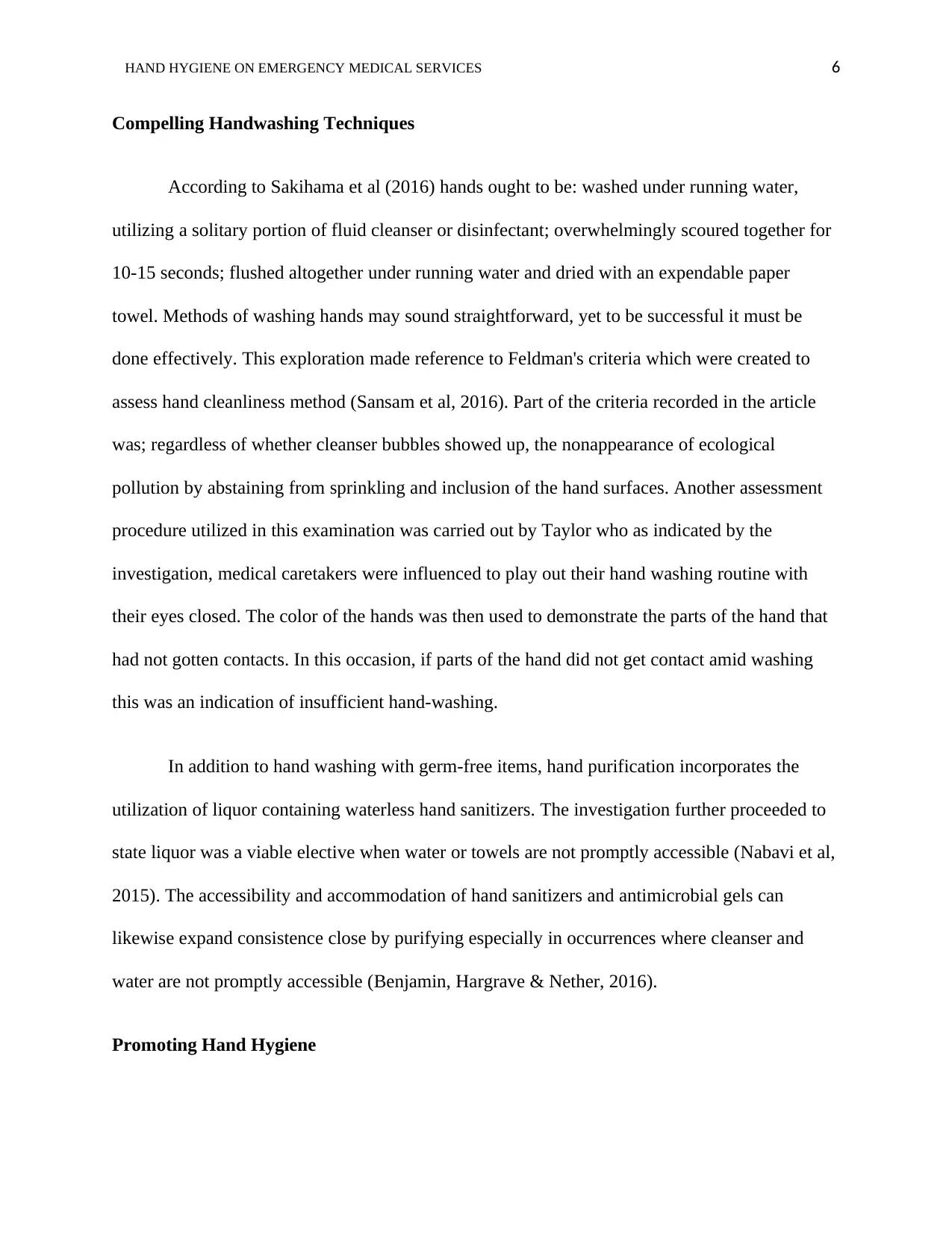
HAND HYGIENE ON EMERGENCY MEDICAL SERVICES 6
Compelling Handwashing Techniques
According to Sakihama et al (2016) hands ought to be: washed under running water,
utilizing a solitary portion of fluid cleanser or disinfectant; overwhelmingly scoured together for
10-15 seconds; flushed altogether under running water and dried with an expendable paper
towel. Methods of washing hands may sound straightforward, yet to be successful it must be
done effectively. This exploration made reference to Feldman's criteria which were created to
assess hand cleanliness method (Sansam et al, 2016). Part of the criteria recorded in the article
was; regardless of whether cleanser bubbles showed up, the nonappearance of ecological
pollution by abstaining from sprinkling and inclusion of the hand surfaces. Another assessment
procedure utilized in this examination was carried out by Taylor who as indicated by the
investigation, medical caretakers were influenced to play out their hand washing routine with
their eyes closed. The color of the hands was then used to demonstrate the parts of the hand that
had not gotten contacts. In this occasion, if parts of the hand did not get contact amid washing
this was an indication of insufficient hand-washing.
In addition to hand washing with germ-free items, hand purification incorporates the
utilization of liquor containing waterless hand sanitizers. The investigation further proceeded to
state liquor was a viable elective when water or towels are not promptly accessible (Nabavi et al,
2015). The accessibility and accommodation of hand sanitizers and antimicrobial gels can
likewise expand consistence close by purifying especially in occurrences where cleanser and
water are not promptly accessible (Benjamin, Hargrave & Nether, 2016).
Promoting Hand Hygiene
Compelling Handwashing Techniques
According to Sakihama et al (2016) hands ought to be: washed under running water,
utilizing a solitary portion of fluid cleanser or disinfectant; overwhelmingly scoured together for
10-15 seconds; flushed altogether under running water and dried with an expendable paper
towel. Methods of washing hands may sound straightforward, yet to be successful it must be
done effectively. This exploration made reference to Feldman's criteria which were created to
assess hand cleanliness method (Sansam et al, 2016). Part of the criteria recorded in the article
was; regardless of whether cleanser bubbles showed up, the nonappearance of ecological
pollution by abstaining from sprinkling and inclusion of the hand surfaces. Another assessment
procedure utilized in this examination was carried out by Taylor who as indicated by the
investigation, medical caretakers were influenced to play out their hand washing routine with
their eyes closed. The color of the hands was then used to demonstrate the parts of the hand that
had not gotten contacts. In this occasion, if parts of the hand did not get contact amid washing
this was an indication of insufficient hand-washing.
In addition to hand washing with germ-free items, hand purification incorporates the
utilization of liquor containing waterless hand sanitizers. The investigation further proceeded to
state liquor was a viable elective when water or towels are not promptly accessible (Nabavi et al,
2015). The accessibility and accommodation of hand sanitizers and antimicrobial gels can
likewise expand consistence close by purifying especially in occurrences where cleanser and
water are not promptly accessible (Benjamin, Hargrave & Nether, 2016).
Promoting Hand Hygiene
⊘ This is a preview!⊘
Do you want full access?
Subscribe today to unlock all pages.

Trusted by 1+ million students worldwide
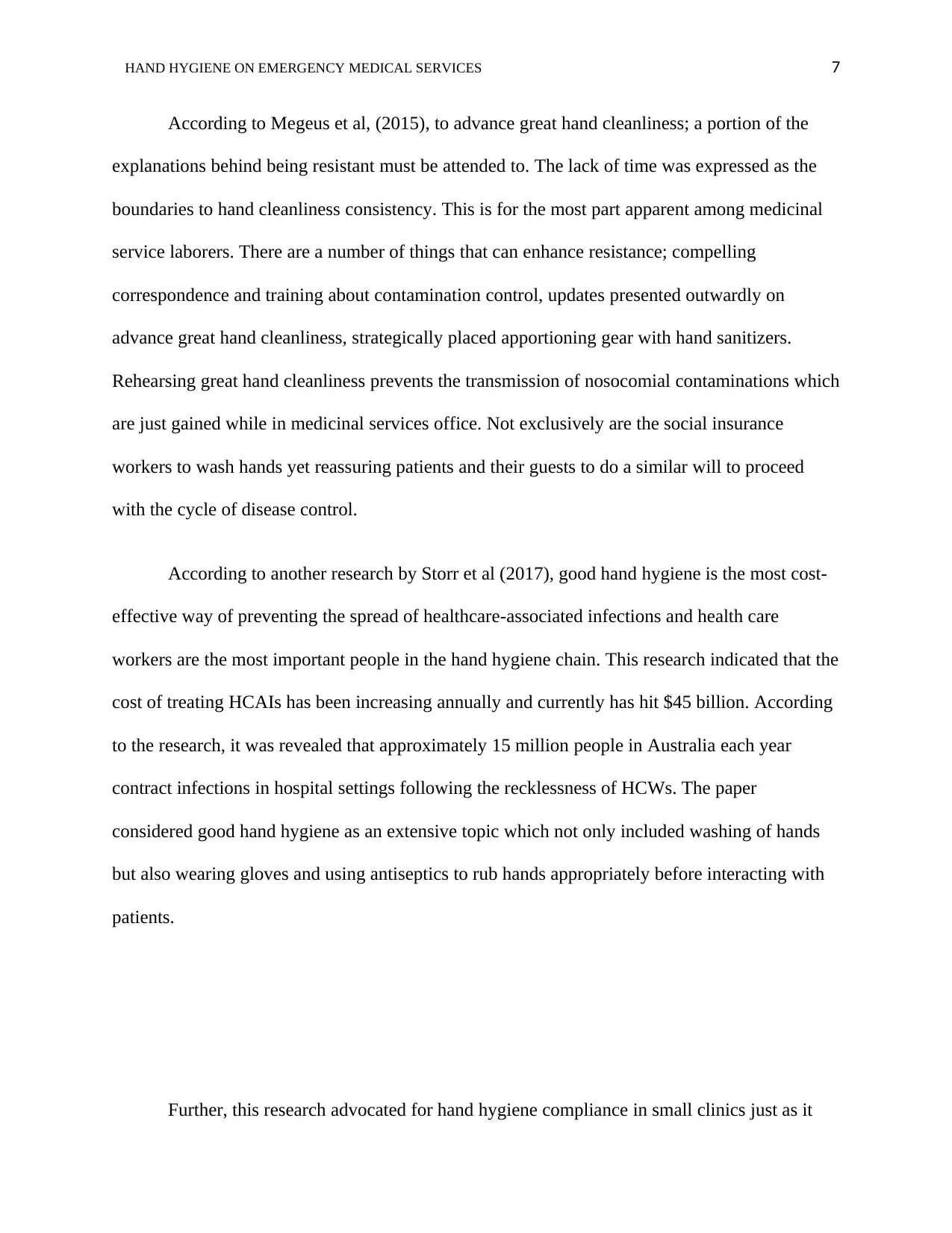
HAND HYGIENE ON EMERGENCY MEDICAL SERVICES 7
According to Megeus et al, (2015), to advance great hand cleanliness; a portion of the
explanations behind being resistant must be attended to. The lack of time was expressed as the
boundaries to hand cleanliness consistency. This is for the most part apparent among medicinal
service laborers. There are a number of things that can enhance resistance; compelling
correspondence and training about contamination control, updates presented outwardly on
advance great hand cleanliness, strategically placed apportioning gear with hand sanitizers.
Rehearsing great hand cleanliness prevents the transmission of nosocomial contaminations which
are just gained while in medicinal services office. Not exclusively are the social insurance
workers to wash hands yet reassuring patients and their guests to do a similar will to proceed
with the cycle of disease control.
According to another research by Storr et al (2017), good hand hygiene is the most cost-
effective way of preventing the spread of healthcare-associated infections and health care
workers are the most important people in the hand hygiene chain. This research indicated that the
cost of treating HCAIs has been increasing annually and currently has hit $45 billion. According
to the research, it was revealed that approximately 15 million people in Australia each year
contract infections in hospital settings following the recklessness of HCWs. The paper
considered good hand hygiene as an extensive topic which not only included washing of hands
but also wearing gloves and using antiseptics to rub hands appropriately before interacting with
patients.
Further, this research advocated for hand hygiene compliance in small clinics just as it
According to Megeus et al, (2015), to advance great hand cleanliness; a portion of the
explanations behind being resistant must be attended to. The lack of time was expressed as the
boundaries to hand cleanliness consistency. This is for the most part apparent among medicinal
service laborers. There are a number of things that can enhance resistance; compelling
correspondence and training about contamination control, updates presented outwardly on
advance great hand cleanliness, strategically placed apportioning gear with hand sanitizers.
Rehearsing great hand cleanliness prevents the transmission of nosocomial contaminations which
are just gained while in medicinal services office. Not exclusively are the social insurance
workers to wash hands yet reassuring patients and their guests to do a similar will to proceed
with the cycle of disease control.
According to another research by Storr et al (2017), good hand hygiene is the most cost-
effective way of preventing the spread of healthcare-associated infections and health care
workers are the most important people in the hand hygiene chain. This research indicated that the
cost of treating HCAIs has been increasing annually and currently has hit $45 billion. According
to the research, it was revealed that approximately 15 million people in Australia each year
contract infections in hospital settings following the recklessness of HCWs. The paper
considered good hand hygiene as an extensive topic which not only included washing of hands
but also wearing gloves and using antiseptics to rub hands appropriately before interacting with
patients.
Further, this research advocated for hand hygiene compliance in small clinics just as it
Paraphrase This Document
Need a fresh take? Get an instant paraphrase of this document with our AI Paraphraser
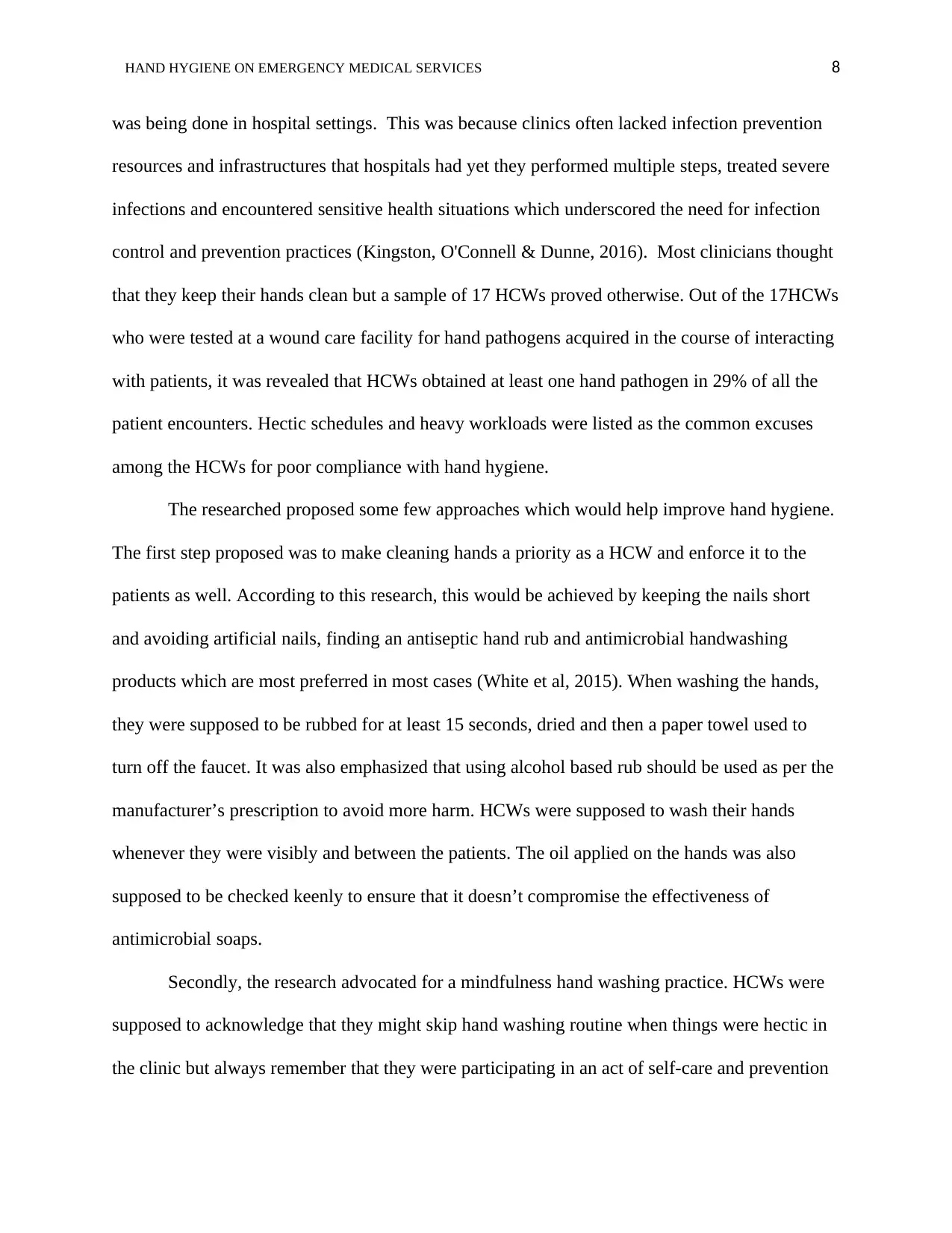
HAND HYGIENE ON EMERGENCY MEDICAL SERVICES 8
was being done in hospital settings. This was because clinics often lacked infection prevention
resources and infrastructures that hospitals had yet they performed multiple steps, treated severe
infections and encountered sensitive health situations which underscored the need for infection
control and prevention practices (Kingston, O'Connell & Dunne, 2016). Most clinicians thought
that they keep their hands clean but a sample of 17 HCWs proved otherwise. Out of the 17HCWs
who were tested at a wound care facility for hand pathogens acquired in the course of interacting
with patients, it was revealed that HCWs obtained at least one hand pathogen in 29% of all the
patient encounters. Hectic schedules and heavy workloads were listed as the common excuses
among the HCWs for poor compliance with hand hygiene.
The researched proposed some few approaches which would help improve hand hygiene.
The first step proposed was to make cleaning hands a priority as a HCW and enforce it to the
patients as well. According to this research, this would be achieved by keeping the nails short
and avoiding artificial nails, finding an antiseptic hand rub and antimicrobial handwashing
products which are most preferred in most cases (White et al, 2015). When washing the hands,
they were supposed to be rubbed for at least 15 seconds, dried and then a paper towel used to
turn off the faucet. It was also emphasized that using alcohol based rub should be used as per the
manufacturer’s prescription to avoid more harm. HCWs were supposed to wash their hands
whenever they were visibly and between the patients. The oil applied on the hands was also
supposed to be checked keenly to ensure that it doesn’t compromise the effectiveness of
antimicrobial soaps.
Secondly, the research advocated for a mindfulness hand washing practice. HCWs were
supposed to acknowledge that they might skip hand washing routine when things were hectic in
the clinic but always remember that they were participating in an act of self-care and prevention
was being done in hospital settings. This was because clinics often lacked infection prevention
resources and infrastructures that hospitals had yet they performed multiple steps, treated severe
infections and encountered sensitive health situations which underscored the need for infection
control and prevention practices (Kingston, O'Connell & Dunne, 2016). Most clinicians thought
that they keep their hands clean but a sample of 17 HCWs proved otherwise. Out of the 17HCWs
who were tested at a wound care facility for hand pathogens acquired in the course of interacting
with patients, it was revealed that HCWs obtained at least one hand pathogen in 29% of all the
patient encounters. Hectic schedules and heavy workloads were listed as the common excuses
among the HCWs for poor compliance with hand hygiene.
The researched proposed some few approaches which would help improve hand hygiene.
The first step proposed was to make cleaning hands a priority as a HCW and enforce it to the
patients as well. According to this research, this would be achieved by keeping the nails short
and avoiding artificial nails, finding an antiseptic hand rub and antimicrobial handwashing
products which are most preferred in most cases (White et al, 2015). When washing the hands,
they were supposed to be rubbed for at least 15 seconds, dried and then a paper towel used to
turn off the faucet. It was also emphasized that using alcohol based rub should be used as per the
manufacturer’s prescription to avoid more harm. HCWs were supposed to wash their hands
whenever they were visibly and between the patients. The oil applied on the hands was also
supposed to be checked keenly to ensure that it doesn’t compromise the effectiveness of
antimicrobial soaps.
Secondly, the research advocated for a mindfulness hand washing practice. HCWs were
supposed to acknowledge that they might skip hand washing routine when things were hectic in
the clinic but always remember that they were participating in an act of self-care and prevention
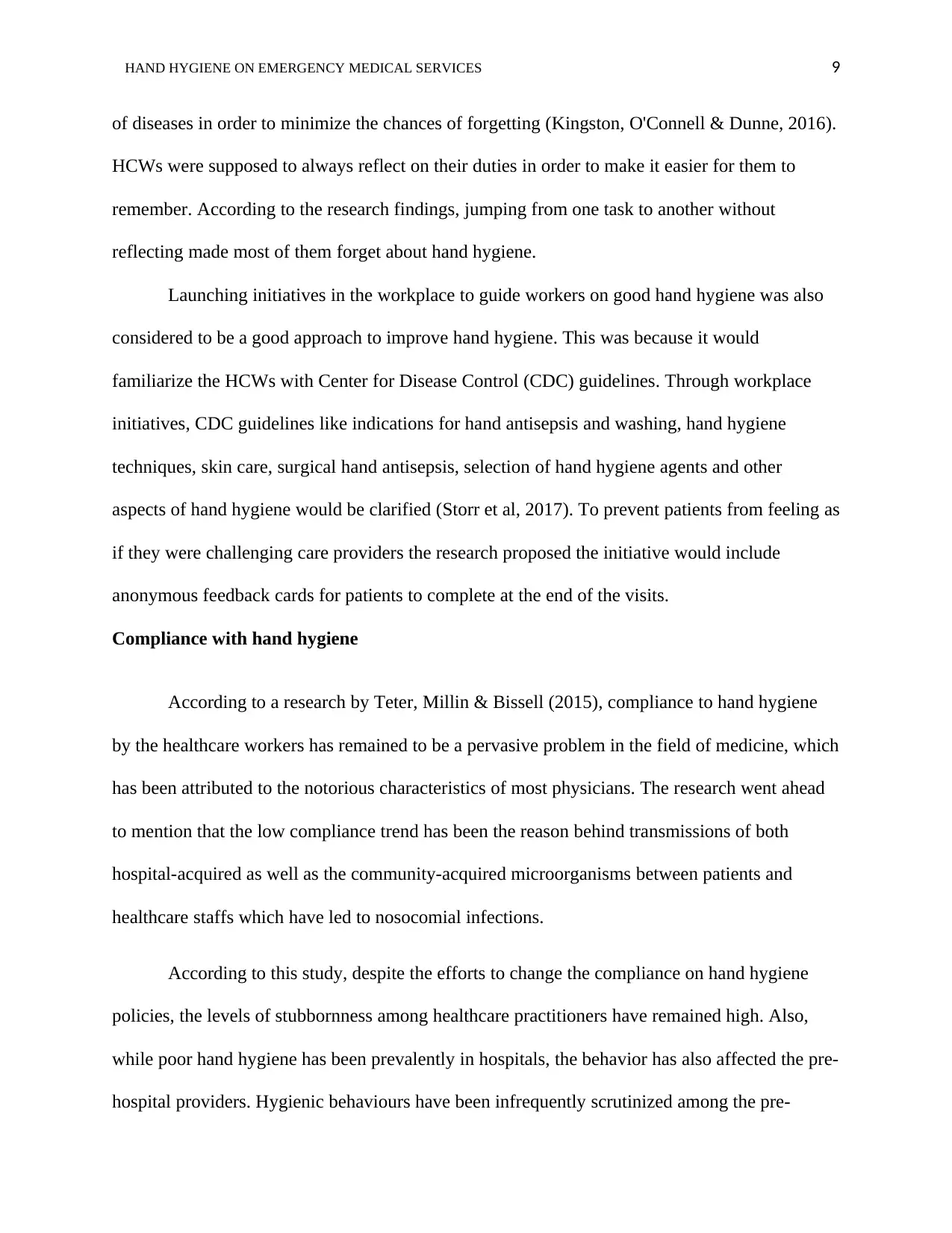
HAND HYGIENE ON EMERGENCY MEDICAL SERVICES 9
of diseases in order to minimize the chances of forgetting (Kingston, O'Connell & Dunne, 2016).
HCWs were supposed to always reflect on their duties in order to make it easier for them to
remember. According to the research findings, jumping from one task to another without
reflecting made most of them forget about hand hygiene.
Launching initiatives in the workplace to guide workers on good hand hygiene was also
considered to be a good approach to improve hand hygiene. This was because it would
familiarize the HCWs with Center for Disease Control (CDC) guidelines. Through workplace
initiatives, CDC guidelines like indications for hand antisepsis and washing, hand hygiene
techniques, skin care, surgical hand antisepsis, selection of hand hygiene agents and other
aspects of hand hygiene would be clarified (Storr et al, 2017). To prevent patients from feeling as
if they were challenging care providers the research proposed the initiative would include
anonymous feedback cards for patients to complete at the end of the visits.
Compliance with hand hygiene
According to a research by Teter, Millin & Bissell (2015), compliance to hand hygiene
by the healthcare workers has remained to be a pervasive problem in the field of medicine, which
has been attributed to the notorious characteristics of most physicians. The research went ahead
to mention that the low compliance trend has been the reason behind transmissions of both
hospital-acquired as well as the community-acquired microorganisms between patients and
healthcare staffs which have led to nosocomial infections.
According to this study, despite the efforts to change the compliance on hand hygiene
policies, the levels of stubbornness among healthcare practitioners have remained high. Also,
while poor hand hygiene has been prevalently in hospitals, the behavior has also affected the pre-
hospital providers. Hygienic behaviours have been infrequently scrutinized among the pre-
of diseases in order to minimize the chances of forgetting (Kingston, O'Connell & Dunne, 2016).
HCWs were supposed to always reflect on their duties in order to make it easier for them to
remember. According to the research findings, jumping from one task to another without
reflecting made most of them forget about hand hygiene.
Launching initiatives in the workplace to guide workers on good hand hygiene was also
considered to be a good approach to improve hand hygiene. This was because it would
familiarize the HCWs with Center for Disease Control (CDC) guidelines. Through workplace
initiatives, CDC guidelines like indications for hand antisepsis and washing, hand hygiene
techniques, skin care, surgical hand antisepsis, selection of hand hygiene agents and other
aspects of hand hygiene would be clarified (Storr et al, 2017). To prevent patients from feeling as
if they were challenging care providers the research proposed the initiative would include
anonymous feedback cards for patients to complete at the end of the visits.
Compliance with hand hygiene
According to a research by Teter, Millin & Bissell (2015), compliance to hand hygiene
by the healthcare workers has remained to be a pervasive problem in the field of medicine, which
has been attributed to the notorious characteristics of most physicians. The research went ahead
to mention that the low compliance trend has been the reason behind transmissions of both
hospital-acquired as well as the community-acquired microorganisms between patients and
healthcare staffs which have led to nosocomial infections.
According to this study, despite the efforts to change the compliance on hand hygiene
policies, the levels of stubbornness among healthcare practitioners have remained high. Also,
while poor hand hygiene has been prevalently in hospitals, the behavior has also affected the pre-
hospital providers. Hygienic behaviours have been infrequently scrutinized among the pre-
⊘ This is a preview!⊘
Do you want full access?
Subscribe today to unlock all pages.

Trusted by 1+ million students worldwide
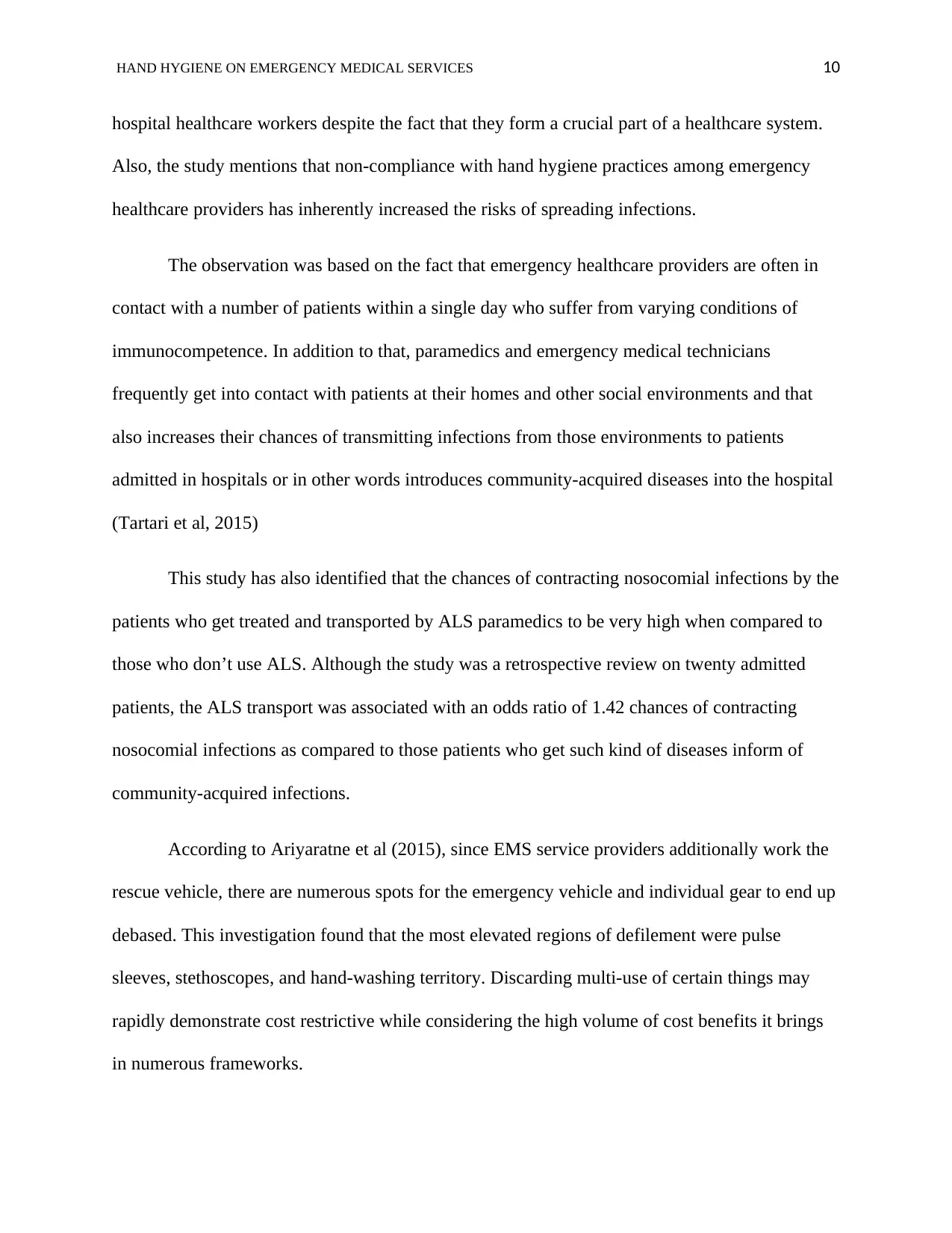
HAND HYGIENE ON EMERGENCY MEDICAL SERVICES 10
hospital healthcare workers despite the fact that they form a crucial part of a healthcare system.
Also, the study mentions that non-compliance with hand hygiene practices among emergency
healthcare providers has inherently increased the risks of spreading infections.
The observation was based on the fact that emergency healthcare providers are often in
contact with a number of patients within a single day who suffer from varying conditions of
immunocompetence. In addition to that, paramedics and emergency medical technicians
frequently get into contact with patients at their homes and other social environments and that
also increases their chances of transmitting infections from those environments to patients
admitted in hospitals or in other words introduces community-acquired diseases into the hospital
(Tartari et al, 2015)
This study has also identified that the chances of contracting nosocomial infections by the
patients who get treated and transported by ALS paramedics to be very high when compared to
those who don’t use ALS. Although the study was a retrospective review on twenty admitted
patients, the ALS transport was associated with an odds ratio of 1.42 chances of contracting
nosocomial infections as compared to those patients who get such kind of diseases inform of
community-acquired infections.
According to Ariyaratne et al (2015), since EMS service providers additionally work the
rescue vehicle, there are numerous spots for the emergency vehicle and individual gear to end up
debased. This investigation found that the most elevated regions of defilement were pulse
sleeves, stethoscopes, and hand-washing territory. Discarding multi-use of certain things may
rapidly demonstrate cost restrictive while considering the high volume of cost benefits it brings
in numerous frameworks.
hospital healthcare workers despite the fact that they form a crucial part of a healthcare system.
Also, the study mentions that non-compliance with hand hygiene practices among emergency
healthcare providers has inherently increased the risks of spreading infections.
The observation was based on the fact that emergency healthcare providers are often in
contact with a number of patients within a single day who suffer from varying conditions of
immunocompetence. In addition to that, paramedics and emergency medical technicians
frequently get into contact with patients at their homes and other social environments and that
also increases their chances of transmitting infections from those environments to patients
admitted in hospitals or in other words introduces community-acquired diseases into the hospital
(Tartari et al, 2015)
This study has also identified that the chances of contracting nosocomial infections by the
patients who get treated and transported by ALS paramedics to be very high when compared to
those who don’t use ALS. Although the study was a retrospective review on twenty admitted
patients, the ALS transport was associated with an odds ratio of 1.42 chances of contracting
nosocomial infections as compared to those patients who get such kind of diseases inform of
community-acquired infections.
According to Ariyaratne et al (2015), since EMS service providers additionally work the
rescue vehicle, there are numerous spots for the emergency vehicle and individual gear to end up
debased. This investigation found that the most elevated regions of defilement were pulse
sleeves, stethoscopes, and hand-washing territory. Discarding multi-use of certain things may
rapidly demonstrate cost restrictive while considering the high volume of cost benefits it brings
in numerous frameworks.
Paraphrase This Document
Need a fresh take? Get an instant paraphrase of this document with our AI Paraphraser
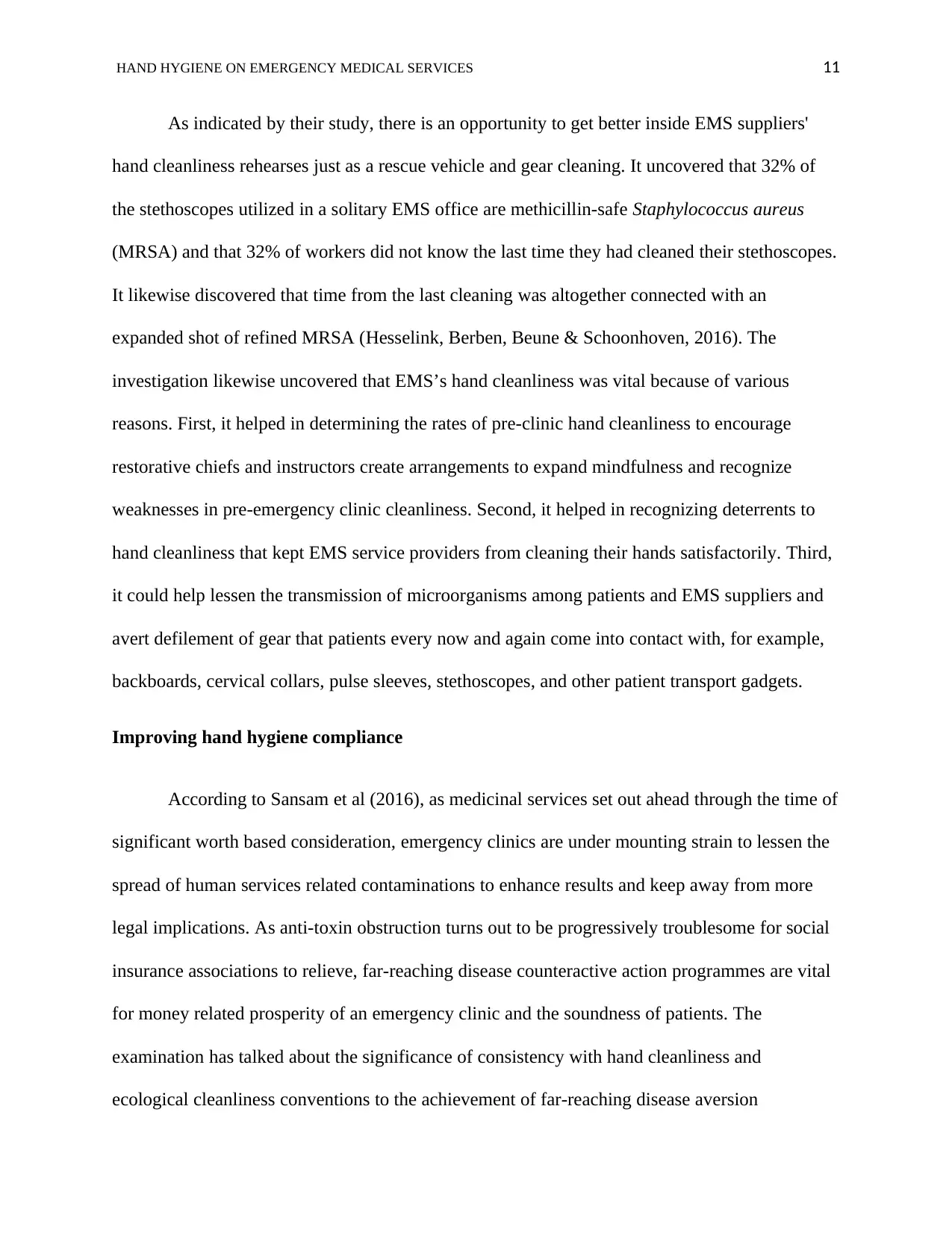
HAND HYGIENE ON EMERGENCY MEDICAL SERVICES 11
As indicated by their study, there is an opportunity to get better inside EMS suppliers'
hand cleanliness rehearses just as a rescue vehicle and gear cleaning. It uncovered that 32% of
the stethoscopes utilized in a solitary EMS office are methicillin-safe Staphylococcus aureus
(MRSA) and that 32% of workers did not know the last time they had cleaned their stethoscopes.
It likewise discovered that time from the last cleaning was altogether connected with an
expanded shot of refined MRSA (Hesselink, Berben, Beune & Schoonhoven, 2016). The
investigation likewise uncovered that EMS’s hand cleanliness was vital because of various
reasons. First, it helped in determining the rates of pre-clinic hand cleanliness to encourage
restorative chiefs and instructors create arrangements to expand mindfulness and recognize
weaknesses in pre-emergency clinic cleanliness. Second, it helped in recognizing deterrents to
hand cleanliness that kept EMS service providers from cleaning their hands satisfactorily. Third,
it could help lessen the transmission of microorganisms among patients and EMS suppliers and
avert defilement of gear that patients every now and again come into contact with, for example,
backboards, cervical collars, pulse sleeves, stethoscopes, and other patient transport gadgets.
Improving hand hygiene compliance
According to Sansam et al (2016), as medicinal services set out ahead through the time of
significant worth based consideration, emergency clinics are under mounting strain to lessen the
spread of human services related contaminations to enhance results and keep away from more
legal implications. As anti-toxin obstruction turns out to be progressively troublesome for social
insurance associations to relieve, far-reaching disease counteractive action programmes are vital
for money related prosperity of an emergency clinic and the soundness of patients. The
examination has talked about the significance of consistency with hand cleanliness and
ecological cleanliness conventions to the achievement of far-reaching disease aversion
As indicated by their study, there is an opportunity to get better inside EMS suppliers'
hand cleanliness rehearses just as a rescue vehicle and gear cleaning. It uncovered that 32% of
the stethoscopes utilized in a solitary EMS office are methicillin-safe Staphylococcus aureus
(MRSA) and that 32% of workers did not know the last time they had cleaned their stethoscopes.
It likewise discovered that time from the last cleaning was altogether connected with an
expanded shot of refined MRSA (Hesselink, Berben, Beune & Schoonhoven, 2016). The
investigation likewise uncovered that EMS’s hand cleanliness was vital because of various
reasons. First, it helped in determining the rates of pre-clinic hand cleanliness to encourage
restorative chiefs and instructors create arrangements to expand mindfulness and recognize
weaknesses in pre-emergency clinic cleanliness. Second, it helped in recognizing deterrents to
hand cleanliness that kept EMS service providers from cleaning their hands satisfactorily. Third,
it could help lessen the transmission of microorganisms among patients and EMS suppliers and
avert defilement of gear that patients every now and again come into contact with, for example,
backboards, cervical collars, pulse sleeves, stethoscopes, and other patient transport gadgets.
Improving hand hygiene compliance
According to Sansam et al (2016), as medicinal services set out ahead through the time of
significant worth based consideration, emergency clinics are under mounting strain to lessen the
spread of human services related contaminations to enhance results and keep away from more
legal implications. As anti-toxin obstruction turns out to be progressively troublesome for social
insurance associations to relieve, far-reaching disease counteractive action programmes are vital
for money related prosperity of an emergency clinic and the soundness of patients. The
examination has talked about the significance of consistency with hand cleanliness and
ecological cleanliness conventions to the achievement of far-reaching disease aversion
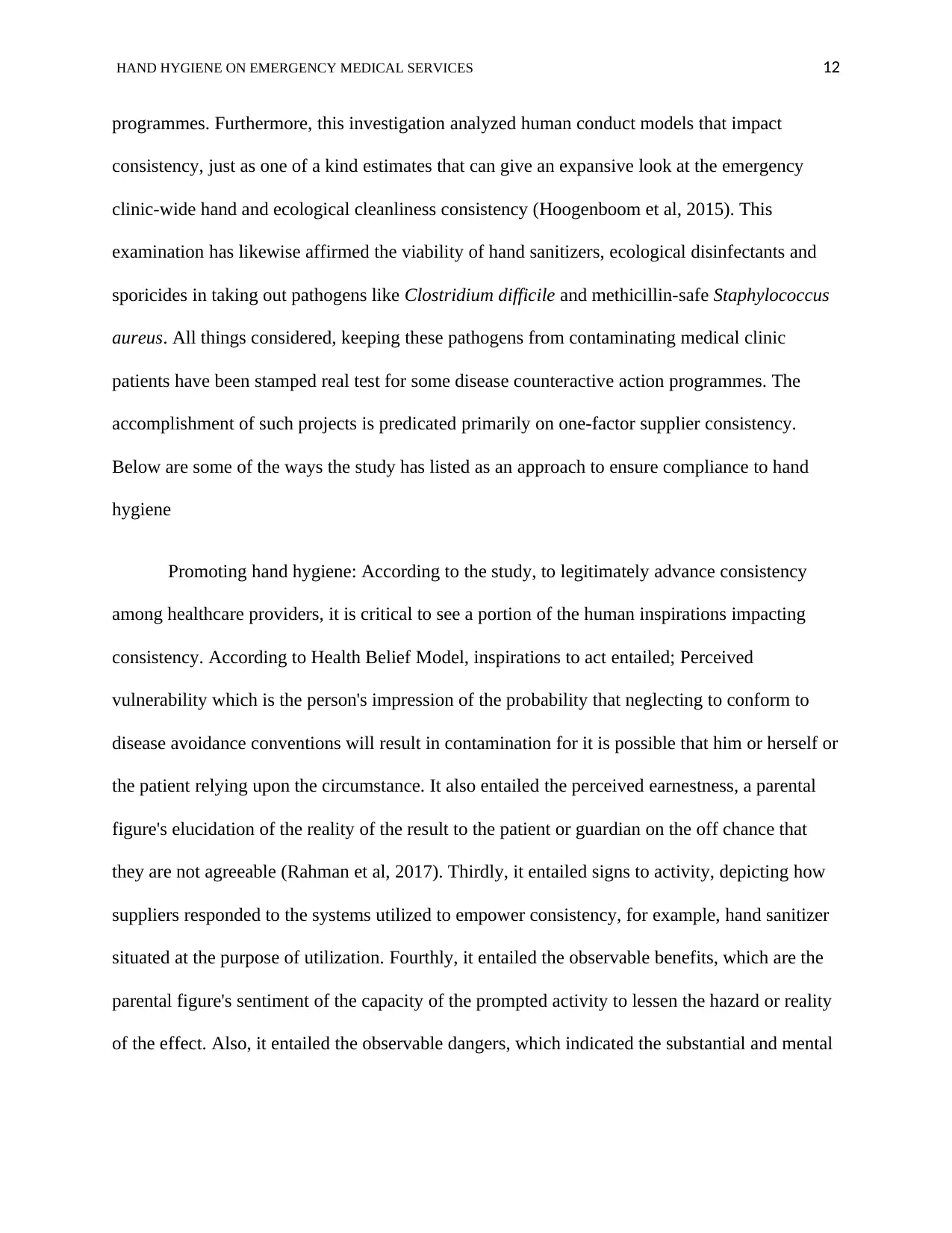
HAND HYGIENE ON EMERGENCY MEDICAL SERVICES 12
programmes. Furthermore, this investigation analyzed human conduct models that impact
consistency, just as one of a kind estimates that can give an expansive look at the emergency
clinic-wide hand and ecological cleanliness consistency (Hoogenboom et al, 2015). This
examination has likewise affirmed the viability of hand sanitizers, ecological disinfectants and
sporicides in taking out pathogens like Clostridium difficile and methicillin-safe Staphylococcus
aureus. All things considered, keeping these pathogens from contaminating medical clinic
patients have been stamped real test for some disease counteractive action programmes. The
accomplishment of such projects is predicated primarily on one-factor supplier consistency.
Below are some of the ways the study has listed as an approach to ensure compliance to hand
hygiene
Promoting hand hygiene: According to the study, to legitimately advance consistency
among healthcare providers, it is critical to see a portion of the human inspirations impacting
consistency. According to Health Belief Model, inspirations to act entailed; Perceived
vulnerability which is the person's impression of the probability that neglecting to conform to
disease avoidance conventions will result in contamination for it is possible that him or herself or
the patient relying upon the circumstance. It also entailed the perceived earnestness, a parental
figure's elucidation of the reality of the result to the patient or guardian on the off chance that
they are not agreeable (Rahman et al, 2017). Thirdly, it entailed signs to activity, depicting how
suppliers responded to the systems utilized to empower consistency, for example, hand sanitizer
situated at the purpose of utilization. Fourthly, it entailed the observable benefits, which are the
parental figure's sentiment of the capacity of the prompted activity to lessen the hazard or reality
of the effect. Also, it entailed the observable dangers, which indicated the substantial and mental
programmes. Furthermore, this investigation analyzed human conduct models that impact
consistency, just as one of a kind estimates that can give an expansive look at the emergency
clinic-wide hand and ecological cleanliness consistency (Hoogenboom et al, 2015). This
examination has likewise affirmed the viability of hand sanitizers, ecological disinfectants and
sporicides in taking out pathogens like Clostridium difficile and methicillin-safe Staphylococcus
aureus. All things considered, keeping these pathogens from contaminating medical clinic
patients have been stamped real test for some disease counteractive action programmes. The
accomplishment of such projects is predicated primarily on one-factor supplier consistency.
Below are some of the ways the study has listed as an approach to ensure compliance to hand
hygiene
Promoting hand hygiene: According to the study, to legitimately advance consistency
among healthcare providers, it is critical to see a portion of the human inspirations impacting
consistency. According to Health Belief Model, inspirations to act entailed; Perceived
vulnerability which is the person's impression of the probability that neglecting to conform to
disease avoidance conventions will result in contamination for it is possible that him or herself or
the patient relying upon the circumstance. It also entailed the perceived earnestness, a parental
figure's elucidation of the reality of the result to the patient or guardian on the off chance that
they are not agreeable (Rahman et al, 2017). Thirdly, it entailed signs to activity, depicting how
suppliers responded to the systems utilized to empower consistency, for example, hand sanitizer
situated at the purpose of utilization. Fourthly, it entailed the observable benefits, which are the
parental figure's sentiment of the capacity of the prompted activity to lessen the hazard or reality
of the effect. Also, it entailed the observable dangers, which indicated the substantial and mental
⊘ This is a preview!⊘
Do you want full access?
Subscribe today to unlock all pages.

Trusted by 1+ million students worldwide
1 out of 19
Related Documents
Your All-in-One AI-Powered Toolkit for Academic Success.
+13062052269
info@desklib.com
Available 24*7 on WhatsApp / Email
![[object Object]](/_next/static/media/star-bottom.7253800d.svg)
Unlock your academic potential
Copyright © 2020–2025 A2Z Services. All Rights Reserved. Developed and managed by ZUCOL.




